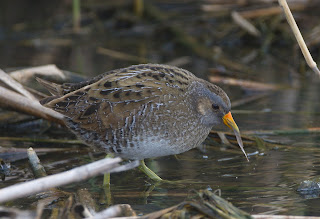The crake patch at Besor has turned up trumps again. All three crakes still there this morning as well as a Little Bittern. This is an uncommon migrant and I've only seen three before - all brief flight views. Strange thing is, I was thinking about Little Bitterns this morning and why I hadn't found any here this Spring. Bitterns are up there with crakes on my birds-I-can't-get-enough-of list so I was thrilled to find one that was actually watchable. This female bird gave the game away by creating vertical lines against horizontal(ish) vegetation.
As I sat down to wait for it to relax it scarpered. I found it later - a lot better concealed.
Once again it scarpered as soon as I lost eye contact with it.
And once again I found it - this time deeper in the reeds.
Two male and two-three female Little, three Spotted and the Baillon's Crake are still busy in the pool. Almost impossible to take a photo the Baillon's with its head sunlit.
The chubby Spotted Crakes don't mind coming out of the shadows.
Clamourous Reed Warblers, Reed Warblers
and Sedge Warblers kept up a noisy performance. Great.
Distant views of Montagu's Harrier
and Great Reed Warbler (distance and heat haze = record shots)
In the last 48 hours two wonderful summer breeders have arrived on site: Rufous Bush Robin
and Roller.
Bee-eaters are looking for nest sites.
Here's something I didn't know - I had always assumed that sunbirds used their long bills to probe for nectar down the throat of the flower
but it seems as though they take a shortcut with this flower and stab directly through to the nectar filled base. No pollination trade-off here.
Had a quick look for wagatils at the composting site but the piles were being turned so I left.
The 'xanthophrys' is still around though.
Finally a gorgeous blue flower - looks like Cichorium endivia but with fewer petals.
And a lucky shot of a dragonfly as I was waiting for the crakes to come out.
This is mainly a record of some of the birds I've seen. Many of the images are, at best, record shots.
Sunday, 16 April 2017
Friday, 14 April 2017
'xanthophrys' Yellow Wagtail
There's a composting site on the way to Besor Reservoir. Wagtails love it.
While scanning the wagtails I noticed this odd looking bird. Yellow supercilium, greenish patch on back of the head, half an eye-ring. To me it looks similar to a bird that Yoav Perlman saw last year in Neot Smadar which he suggested was a xanthophrys/superciliaris mix (see article here). The bird here fits the bill for xanthophyris, an intergrade between feldegg and either lutea, flava or beema, and an unusual visitor from the east of the superciliaris range.
Possibly odder is this bird with yellow flecks swirling on its cheeks.
Other birds around - the three crakes are still in evidence (one Baillon's, three Little and three Spotted), the Spotted in particular looking well fattened up for the next migration stage.
On the access road to the reservoirs I found a lovely pair of Namaqua Doves,
and this Great Spotted Cuckoo that happened across a huge caterpillar and had to awkwardly climb down the fence to reach it.
Many Lesser Spotted Eagles around this morning.
Great Reed Warblers have arrived.
Montagu's Harriers moving through.
And Whinchats. Spring plumage male Whinchats are incredible birds. So bright!
Finally, a nice surprise to see this tree frog. Apparently they are not unusual but I hear many more amphibians than I see.
Subscribe to:
Posts (Atom)
NW India - 9th to 22nd February 2020 (Kosi River, Corbett NP, Haripur Dam, Pangot, Sattal, Chopta, Walterre)
If you look through the Birds of the Indian Subcontinent (Grimmett, Inskipp and Inskipp, 2011) you cannot help noticing the huge range of s...

-
Spent the weekend in Eilat. Met up with Shachar at the bird park which was quiet except for some Penduline Tits. We then headed for the date...
-
We had one final morning before we had to return to Tbilisi for flights back home. Where else to go then but the famed Armash fish ponds?...
-
Israel 10 – 17 March 2013 Introduction After a gap in 2012 (which was a shame because it was a vintage year for spring migration i...
































































